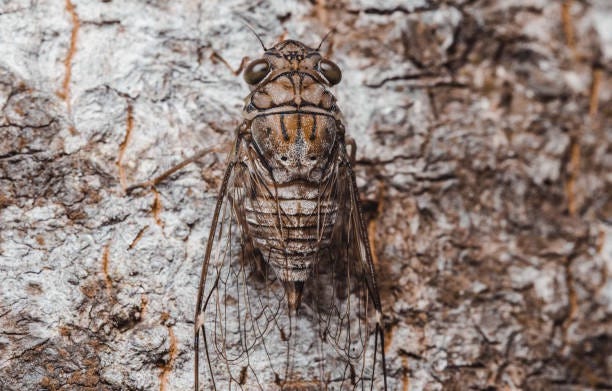Occasionally, a partial or complete eclipse, the sighting of a distant star, of two planets “kissing,” will tie us to an interval longer than the three hundred and sixty-five days of the year. The emergence of the cicadas is one of these moments, a wrinkle in time, a glimpse of the incomprehensible world that expands beyond us in all directions.
— Chasing Cicadas by Anisa George. Emergence Magazine
Sometime we become drawn to certain sounds across the span of our lifetimes.
Sometimes certain sounds become drawn to us. Inexplicably so, they repeat, recur, intervene like patterns stitched into script, cunningly composed like something plucked from the plot of a Christopher Nolan film.
Type “…cicada sound…” into Google and the first question that spawns is :
“Why do cicadas make that awful noise?”
The answer —
Male cicadas have sound boxes in their abdomens. They make their sound by expanding and contracting a membrane called a tymbal. They use their sound to attract females, which make clicking noises when they are ready to mate. The hotter the day, the louder the male cicadas make their sounds.
The song of the cicada has for some time provided me with a source of fascination. How can something so small yet barely visible create such cacophonous sound? How many hundreds/thousands dwell just inches from us camouflaged amongst the verdure - invisible ravers in the festival of summer.
I first encountered the cicada visiting France. Their omnipresence in the Provençal countryside is overwhelming to newcomers, yet passes almost unnoticed by locals.
I would spend much of my time reading in the afternoon sun, whilst natives snoozed during their siestes, listening to the insect orchestra perform in the garden. The sounds became almost hypnotic. Listen long enough and it’s almost as though Nature herself is buzzing, pulsing, vibrating. Those who describe the sound as awful must have themselves become too naturalised to the constant hum, roar and rumble of modern urban living.
Me — give me cicada over scooter anytime!
The above recording was made last summer whilst visiting my wife’s parents home in the Gard region of Southern France.
Surrounded by pines and plane trees, perfect habitats for cicadas, this hissing ksh-ksh runs from noon til night. In the case of a heatwave, which have become increasingly common in the Gard region, sound levels can reach up to 90dB. Occasionally a fragile golden husk can be found clinging to a trunk — their transitory baggage discarded after emerging from their subterranean refuge.
It wasn’t until I travelled to Japan in the Summer of 2019 that I discovered the diaspora of even more deafening and mysterious kind…
This hypnotic trill was recorded at Yanaka Cemetery in Tokyo, right next to the JR Nippori station to the north of Ueno district. We can hear the arriving and departing of trains, the calling of crows and the pleasant subdued rhythm of a nearby temple bell coming and going beneath the cicada’s song.
This is the abura-zemi (油蝉) (graptopsaltria nigrofuscata).
Visit Tokyo in the summer and the abura-zemi will most likely welcome you. This reddish-brown species of cicada surfaces around early July and announces its arrival with sounds reminiscent of a 56k dialup modem, though that is not how the cry sounds like to Japanese ears. “Abura” means “oil” in Japanese, and the reason this insect bears this name is because its characteristic jiijii cry apparently sounds a little like boiling oil.
Here we have the minmin-zemi (ミンミンゼミ) (hyalessa maculaticollis). The cicada that you’ll most often hear in movies or animated shows whenever they want to quickly establish that a scene is taking place in the summer. The minmin-zemi are found throughout all of Japan, even on the country’s northernmost island of Hokkaido. As such, they are the most symbolic, as is their song, the written records of which go back hundreds of years.
They have some serious moves too!
Before continuing, I’m just curious to know…
This teetering melody belongs to the higurashi (茅蜩) (tanna japonensis).
Recorded here deep in the cedar forests of Mt. Haguro in the Northern Yamagata Prefecture, higurashi are widely considered to be the most pleasant-sounding cicada in Japan. The peak time for hearing them is autumn, as the summer fades. It is the males who sing with this distinctive, melancholic song typically heard before sunrise, at twilight or dusk, when the temperature has dropped.
I often recall their accompaniment during those moments of reflection watching the sunset from my seat on the engawa, a Japanese veranda, offering a wonderful vantage point to sit and contemplate the wonders of the natural world.
So as you can see, I’ve become quite attached to these strange, wonderful creatures. After an initial worry subsided for recording anything other than cicadas during my stay in Japan - their accompaniment soon soothed me into appreciating their presence — encountering a world I had never known before.
You can check out other recordings from my project exploring the relationship between sound, nature and spirituality in Japan here. The collection was supported by The British Library Sound Archive.
https://www.materichart.com/japancollection
“…even though I’d sat for an hour under a stupendous sycamore tree that echoed with song like the vaulted ceiling of a cathedral—I was still hungry for something, for the feeling of being inside the chorus, for that deafening, jet-level whirr.”
- Anisa George
Sonic Tapestries will remain free to all subscribers.
Your kind support helps me to grow my audience and continue on my creative path.
If you do like reading along and want to help support my work further, please consider sharing this post with your friends, family and followers.
Thank you for being here with me.
Mat
🌻






